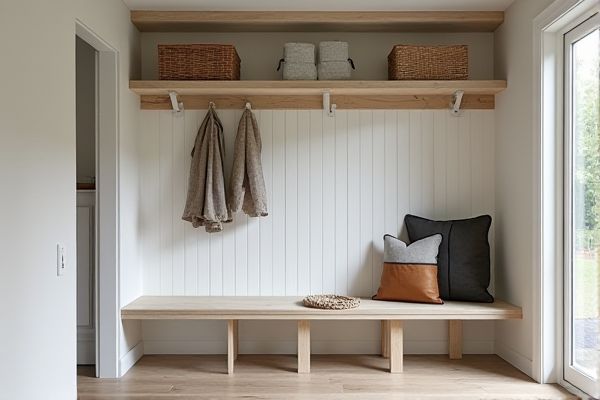
Ventilated shelving in mudrooms promotes air circulation, reducing moisture buildup and preventing mold, while solid shelving offers a sturdier surface for storing heavier items but may trap humidity. Explore the rest of the article to discover which shelving type best suits Your mudroom needs and maintenance preferences.
Table of Comparison
| Feature | Ventilated Shelving | Solid Shelving |
|---|---|---|
| Airflow | Allows air circulation, reduces moisture buildup | No airflow, can trap moisture |
| Durability | Generally sturdy but may have gaps | Typically more robust and solid |
| Cleaning | Easy to clean, dirt falls through gaps | May require more effort to clean surface |
| Storage | Best for items needing ventilation like shoes | Better for storing smaller or loose items |
| Appearance | Open, airy look | Sleek, uniform look |
| Price | Often more affordable | Can be more expensive depending on material |
Introduction to Mudroom Shelving Options
Mudroom shelving options include ventilated and solid designs, each serving distinct purposes for organizing and maintaining your space efficiently. Ventilated shelving promotes air circulation, helping wet or damp items dry faster and reducing mildew buildup, which is ideal for shoes and outerwear. Solid shelving offers a sturdy surface for heavier items and provides a cleaner look by hiding clutter, enhancing storage versatility in your mudroom.
Overview of Ventilated Shelving
Ventilated shelving in mudrooms enhances air circulation, reducing moisture buildup and preventing mold growth on stored items. Typically made of metal or wire grids, these shelves allow dirt and debris to fall through, making cleaning easier and maintaining a cleaner storage environment. Compared to solid shelving, ventilated options improve durability by minimizing water damage and promoting quicker drying of wet gear.
Overview of Solid Shelving
Solid shelving in mudrooms offers sturdy, uniform surfaces ideal for storing heavier items and keeping belongings dust-free. Its continuous structure prevents smaller items from falling through gaps, enhancing organization and safety. Solid shelves are typically easier to clean and maintain, making them a practical choice for mudrooms subject to dirt and moisture.
Airflow and Moisture Control
Ventilated shelving in your mudroom enhances airflow, reducing moisture buildup and preventing mold or mildew growth, which is critical for maintaining a fresh, dry environment. Solid shelving, while sturdy, can trap moisture and limit ventilation, potentially leading to dampness and unpleasant odors. Choosing ventilated shelves optimizes air circulation, helping your mudroom stay cleaner and healthier.
Durability and Maintenance
Ventilated shelving in mudrooms offers superior durability by preventing moisture buildup, which reduces the risk of rust and mold compared to solid shelving. Its open design allows for better airflow, making cleaning easier and minimizing dust accumulation, thereby lowering maintenance efforts. Your choice of ventilated shelving ensures long-lasting performance and a cleaner, more hygienic storage solution.
Storage Versatility and Customization
Ventilated shelving in mudrooms offers superior storage versatility by allowing air circulation, which helps prevent moisture buildup on items like boots and wet gear, making it ideal for varied storage needs. Solid shelving provides a flat, stable surface better suited for storing smaller or delicate items, enabling more customized organization with bins and baskets. Choosing between ventilated and solid shelving depends on optimizing airflow requirements versus maximizing surface area for personalized storage solutions.
Aesthetic Considerations
Ventilated shelving in mudrooms offers a lightweight, airy look that enhances visual openness and prevents the buildup of odors by allowing air circulation around stored items. Solid shelving provides a more traditional, streamlined appearance that can hide clutter and create a neat, uniform surface but may trap moisture and odors. Choosing between the two depends on aesthetic preferences and the desire for either an open, breathable design or a sleek, concealed storage solution.
Installation and Cost Comparison
Ventilated mudroom shelving offers easier installation due to its lightweight design and fewer mounting requirements, reducing labor time and associated costs compared to solid shelving. Solid shelving often demands sturdier brackets, precise measurements, and potentially professional installation, increasing overall expenses. Your choice between these options will impact both initial installation complexity and cost efficiency.
Best Use Cases for Each Shelving Type
Ventilated shelving works best in mudrooms where moisture control is crucial, allowing air to circulate and helping to dry wet shoes and gear quickly. Solid shelving is ideal for storing smaller items or containers that require a stable, flat surface free from dust or debris. Your choice depends on whether you prioritize airflow and drying or stable, clean storage space.
Conclusion: Choosing the Right Mudroom Shelving
Ventilated shelving in your mudroom promotes airflow, reducing moisture buildup and preventing mold, which is ideal for damp or wet environments. Solid shelving provides a sturdy, clean surface for storage but may trap moisture, making it less suitable for items that need ventilation. Selecting the right mudroom shelving depends on your specific storage needs and the typical humidity levels in your space.
 homyna.com
homyna.com